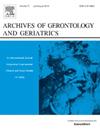Evaluating sleep patterns and intrinsic capacity with machine learning: Results from the Gan-Dau healthy longevity plan
IF 3.8
3区 医学
Q2 GERIATRICS & GERONTOLOGY
引用次数: 0
Abstract
Background
This study aims to examine the association between sleep and intrinsic capacity (IC), employing a machine-learning approach, to promote healthy aging and disability prevention in the community.
Methods
A cohort of 810 community-dwelling individuals aged 50 years were enrolled. Sleep patterns were assessed using the Pittsburgh Sleep Quality Index (PSQI) and its subdomains. Unsupervised machine learning through K-means clustering was applied to classify sleep patterns into four distinct categories, enabling further analysis. IC was evaluated by assessing cognitive, locomotion, vitality, psychological, and sensory functions and was subsequently rescaled using the percent of the maximum possible method.
Results
Low IC was linked to higher PSQI (OR 1.10, 95% CI 1.05-1.15, p<0.001), as well as subdomains indicating poor sleep quality, lower habitual sleep efficiency, and increased sleep disturbances. Poor sleep quality (PSQI >5) was associated with low IC and lower scores in the psychological wellbeing, and vitality subdomains. Results of K-means clustering analysis showed: Category 1 (worst sleepers) (OR 2.54, 95% CI 1.55-4.16, p<0.001), Category 2 (short and inefficient sleepers, OR 1.69, 95% CI 1.18-2.43, p=0.004), and Category 3 (inefficient sleepers, OR 1.50, 95% CI 1.02-2.20, p=0.037) exhibited a higher risk for low IC compared to robust sleepers.
Conclusions
The study highlights the crucial role of sleep quality in maintaining intrinsic capacity and promoting healthy aging. Impairments in psychological wellbeing and vitality were identified as the primary contributors. This emphasizes the importance of promoting healthy sleep habits for overall well-being.
用机器学习评估睡眠模式和内在能力:来自甘道健康长寿计划的结果
本研究旨在研究睡眠与内在能力(IC)之间的关系,采用机器学习方法,促进社区的健康老龄化和残疾预防。方法对810名50岁的社区居民进行队列研究。使用匹兹堡睡眠质量指数(PSQI)及其子域评估睡眠模式。通过K-means聚类的无监督机器学习被应用于将睡眠模式分为四个不同的类别,从而进行进一步的分析。通过评估认知、运动、活力、心理和感觉功能来评估IC,随后使用最大可能百分比法重新缩放IC。结果慢IC与较高的PSQI (OR 1.10, 95% CI 1.05-1.15, p<0.001)以及表明睡眠质量差、习惯性睡眠效率低和睡眠障碍增加的子域有关。睡眠质量差(PSQI >5)与低IC以及心理健康和活力子域得分较低相关。k -均值聚类分析的结果显示:第一类(最差睡眠者)(OR 2.54, 95% CI 1.55-4.16, p<0.001)、第二类(短睡眠者和低效睡眠者,OR 1.69, 95% CI 1.18-2.43, p=0.004)和第三类(低效睡眠者,OR 1.50, 95% CI 1.02-2.20, p=0.037)与健康睡眠者相比,低IC的风险更高。结论本研究强调了睡眠质量在维持内在能力和促进健康衰老方面的重要作用。心理健康和活力的损害被确定为主要因素。这强调了促进健康睡眠习惯对整体健康的重要性。
本文章由计算机程序翻译,如有差异,请以英文原文为准。
求助全文
约1分钟内获得全文
求助全文
来源期刊
CiteScore
7.30
自引率
5.00%
发文量
198
审稿时长
16 days
期刊介绍:
Archives of Gerontology and Geriatrics provides a medium for the publication of papers from the fields of experimental gerontology and clinical and social geriatrics. The principal aim of the journal is to facilitate the exchange of information between specialists in these three fields of gerontological research. Experimental papers dealing with the basic mechanisms of aging at molecular, cellular, tissue or organ levels will be published.
Clinical papers will be accepted if they provide sufficiently new information or are of fundamental importance for the knowledge of human aging. Purely descriptive clinical papers will be accepted only if the results permit further interpretation. Papers dealing with anti-aging pharmacological preparations in humans are welcome. Papers on the social aspects of geriatrics will be accepted if they are of general interest regarding the epidemiology of aging and the efficiency and working methods of the social organizations for the health care of the elderly.

 求助内容:
求助内容: 应助结果提醒方式:
应助结果提醒方式:


